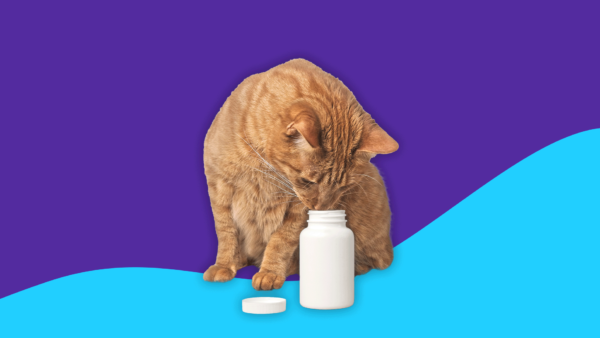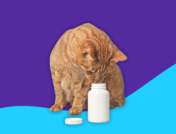Like humans and dogs, cats can get car sick. You may want to take your pet with you on your travels while avoiding messy and stressful situations en route. Read on to learn how to treat and prevent motion sickness in cats.
Can cats get car sick?
There are a few reasons your feline friend might be having a rough time in the car. One reason is “the stress and anxiety many cats experience when traveling by car, as they generally don’t do it often,” says Megan Conrad, BVMS, a veterinarian with Hello Ralphie. “Motion sickness also happens because your pet’s brain is getting conflicting signals from sensory organs like the inner ear.”
Is it dangerous for a cat to be car sick?
No one likes cleaning up vomit on vacation. Not only is it unpleasant—but in your cats it can lead to additional health risks. “Motion sickness is not fatal,” Dr. Conrad says, “but it can be extremely uncomfortable for your cat and cause symptoms such as nausea, vomiting, and dizziness.” says Dr. Conrad. Vomiting can lead to dehydration, which can become dangerous for cats. Dizziness can lead to injury.
What to do if your cat gets car sick
If you’re on the road and your cat begins to feel uncomfortable, there are a few ways to help. “If your cat’s motion sickness is mainly due to the inner ear’s vestibular system being out of whack, it should get better once the motion of the vehicle stops,” Dr. Conrad says. The car sickness may also clear up on its own within half an hour.
You know your pet, so be sure to watch for signs of anxiety. “If stress is contributing to the problem, your kitty may start showing symptoms even before the car starts moving,” Dr. Conrad explains. “If you notice your cat is panting or open-mouth breathing in the car, and the temperature is cool, it’s likely a sign that they’re stressed.” Stress-induced car sickness will not necessarily get better once you’re underway or with time.
If you have a long car ride ahead of you, frequent breaks will prevent stress and break up the time in motion, which may reduce motion sickness. “Cats can ride in a car for long stretches of up to eight hours,” says Chyrle Bonk, DVM, a veterinarian working with Hepper. “However, they should be let out of their carrier every four to six hours to stretch.” They will also need adequate water and a litter box.
Prevent car sickness in cats
If your pet has a history of motion sickness, you will want to try to set them up for success on future car adventures. First make them comfortable in a good-fit cat carrier. It should be roomy enough for the cat to stand and turn around in, says Dr. Conrad.
It’s good to get them acclimated to the carrier before you need to travel. “Keep the carrier in your cat’s living area so it’s a familiar sight, instead of only bringing it out for a car trip,” Dr. Conrad recommends. “Once your cat is more comfortable with the carrier, have them sit in it in the car without going anywhere, then move on to short drives. Gradually increase the trip length.”
This breaking-in period could take several days or even weeks, explains Dr. Bonk. It’s important to include lots of rewards in these sessions. Additional tips for easing them into the carrier is putting their bedding or toys inside of it or putting a towel over it so they can have a hiding cave.
In addition to acclimating your cat to its carrier, once traveling, you should keep the car quiet and cool. This will help keep them calm and relaxed.
Finally, consider traveling around your cat’s feeding times. “If riding in the car makes your cat nauseated, withhold food before a trip,” Dr. Conrad recommends. Dr. Bonk adds that you may need to withhold food for up to 12 hours before traveling in order to prevent vomiting.
When to see a veterinarian
If none of these tips and tricks work, it’s time to make an appointment with your cat’s veterinarian to find a proper treatment.
There are some over-the-counter remedies that are safe for cats. They include:
- Pheromone sprays, wipes, or collars
- Calming chews or supplements
- Dramamine (meclizine HCl)
- Antihistamines like Benadryl can be sedating for some cats
For all of the above, it’s imperative to ask your vet for the proper dose before giving it to your feline friend.
RELATED: Help! My pet ingested one of my pills
If OTC options don’t work, your cat may do better with prescription medications for anxiety or an anti-emetic to prevent vomiting. Your vet can prescribe them—and if they are filled at a human pharmacy, you can use your SingleCare discount card! These include:
- Trazodone, a common sedative and anti-anxiety medication
- Short acting anti-anxiety medications such as Xanax
- Gabapentin, a pain medication that causes sedation
- Maropitant, an anti-emetic medication to prevent vomiting
- Long term anti-anxiety medications like Prozac, Zoloft or amitriptyline may be prescribed for more generalized anxiety, or to help a pet adjust to a new home
Some of these meds are for more short-term anxiety, but others can be prescribed to cats who have long-term anxiety. Be sure to speak with your vet about the best options for your cat. He or she—and your car seat—will thank you!











